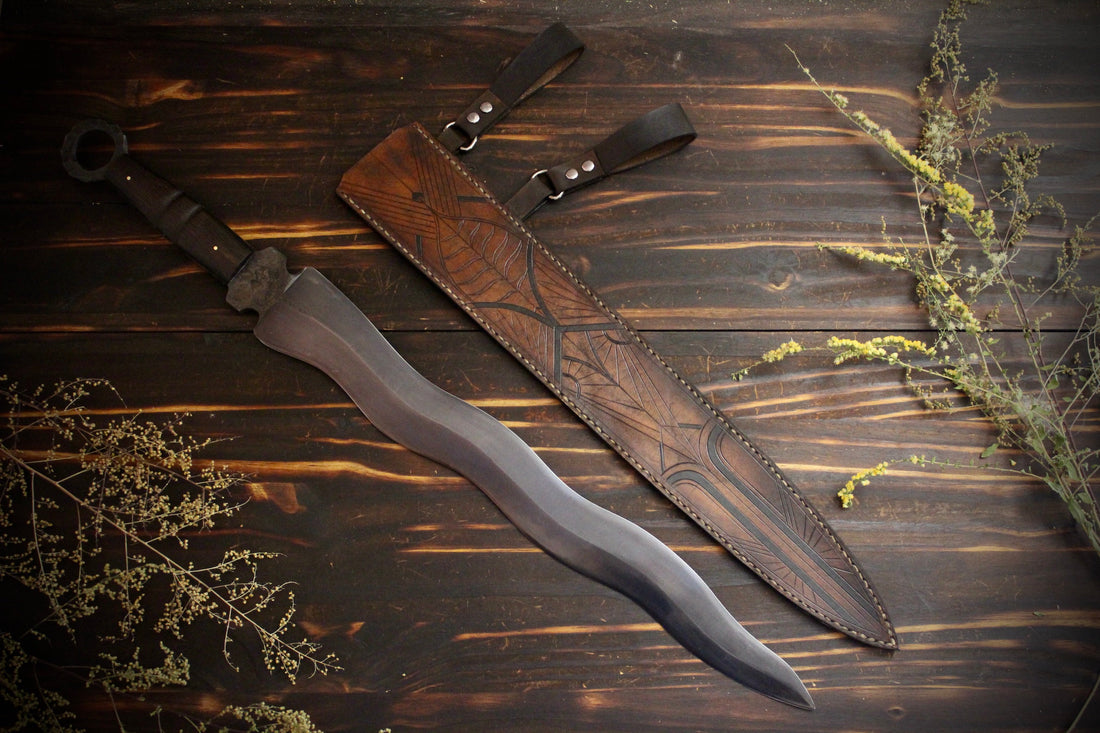
Kris Sword, a Masterpiece from the East
Share
History of Kris Sword
The Kris sword is a unique, asymmetrical dagger with a distinctive wavy blade, originating from Indonesia and Malaysia. The Kris sword has a very long and rich history that spans centuries and throughout multiple cultures in Southeast Asia. The exact origins of the Sword are unclear, but it is believed to have been developed in the Island of Java, Indonesia, around the 9th century.
The Kris was originally designed as a weapon for close combat, with a blade that could be used for stabbing or slicing. Over time, the weapon became a symbol of power and status, with many different variations developed for use by different social classes and professions.
The Kris sword was also associated with spirituality and magic. It was commonly believed that the blade had supernatural powers that could be used to ward off evil presence and bring good luck. Many Kris swords were adorned with intricate carvings, inscriptions, and even gemstones to enhance their spiritual potency.
The Kris sword spread throughout Asian Countries, and with different regions developed their own distinct variations and styles. In Malaysia and the Philippines, for example, the Kris evolved into a more elaborate and decorative weapon, with ornate handles and blades.
Kris Sword Shape and Texture
The Kris sword is a distinctive weapon with a wavy or serpentine blade that originates from Southeast Asia, particularly Indonesia, Malaysia, and the Philippines. The blade of the Kris is typically made from layered steel, which gives it its unique wavy pattern.
The shape of the Kris sword is characterized by a double-edged blade that has a pronounced curve and a distinctive wavy pattern. The curve of the blade is often compared to that of a snake, which is fitting considering that the word "Kris" is believed to be derived from the Old Javanese word "keris" or "kerises," meaning "to slice like a serpent."
The handle of the Kris sword is also notable, featuring a distinctive wavy design that complements the blade. The handle is often made from materials such as wood, ivory, or bone, and may be embellished with intricate carvings or decorative elements.
Overall, the Kris sword is a unique and recognizable weapon with a distinctive shape that reflects the cultural and historical traditions of Southeast Asia.
Kris Sword around the World
There are many different examples of Kris swords, each with their own unique style and history. Here are a few notable examples:
- Kris Panjang: This is a long and slender Kris sword, often with a blade that measures over 60 centimeters in length. It is considered a more elegant and refined style, often used by royalty or other high-ranking individuals.
- Kris Taming Sari: This Kris sword is named after a mythical weapon said to have belonged to the legendary Malaccan warrior, Hang Tuah. It resembles a tiger's claw featuring a curved blade with a unique shape.
- Kris Luk 5: This is a type of Kris sword that features five small blades or prongs on the top of the hilt. It is believed to be a symbol of protection and is often given as a gift to those in need of protection.
- Kris Pusaka: This type of Kris sword is considered to be an ancestral weapon, passed down through generations of a family. It is often highly decorated and has a significant spiritual and cultural value to the family who owns it.
- Kris Bali: This is a type of Kris sword that originates from the island of Bali, Indonesia. It features a highly ornate handle and a blade with a pronounced curve. It is often used in traditional Balinese ceremonies and dances.
These are just a few examples of the many different types of Kris swords that exist, each with their own unique history and cultural significance.
How to make Kris Sword
Forging a Kris sword requires skill and expertise in metallurgy, as well as a deep understanding of the cultural and spiritual significance of the weapon. Traditionally, Kris swords were forged by skilled artisans who used a combination of heating, hammering, and folding techniques to create the distinctive wavy blade. Today, there are still some craftsmen who continue to produce Kris swords using traditional methods, although the practice is becoming increasingly rare. Many modern forgers use more advanced techniques and materials to create their swords, but still strive to honor the rich cultural legacy and symbolism of the Kris.
Making a Kris sword involves a complex process that requires skill and expertise. Firstly, the blade is forged from layers of steel, which are heated and hammered together to create a strong and durable blade. The blade is then shaped and ground to create the distinctive wavy pattern. The handle is made separately and attached to the blade using a metal collar. The handle is often made from materials such as wood, bone, or ivory, and may be carved with intricate designs. The final step involves sharpening and polishing the blade to create a smooth and sharp cutting edge. Overall, making a Kris sword is a time-consuming process that requires precision and attention to detail.
Kris Sword Today
Today, the Kris sword is primarily used as a decorative or ceremonial item, rather than a functional weapon. It is highly valued for its artistic and cultural significance, with many collectors and enthusiasts seeking out antique and rare examples. The Kris sword remains an important symbol of Southeast Asian culture and heritage, with a rich history and ongoing significance in both traditional and modern contexts. It is often used in cultural performances, weddings, and other important events. Additionally, many people still believe in the supernatural powers of the Kris sword, and it is considered a powerful talisman in some communities.
By SerunicHome
